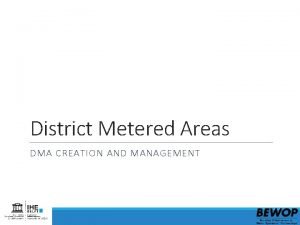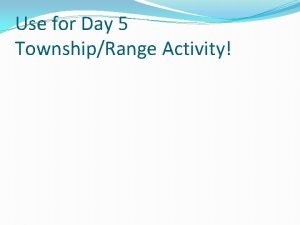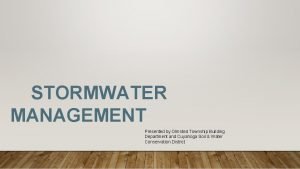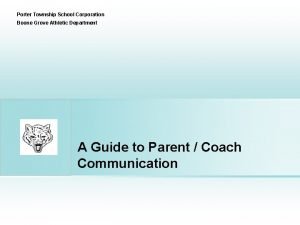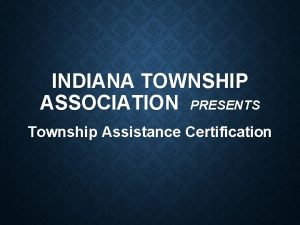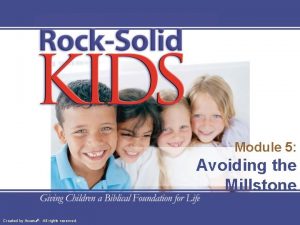Millstone Township Schools District Presentation 2009 2010 Child






































- Slides: 38

Millstone Township Schools District Presentation 2009 -2010

Child Abuse/Neglect

Child Abuse/Neglect • • • Definition Common Signs If you Suspect Responsibility to Report Millstone Board of Education Policy – Reporting – Indications

Child Abuse • An “abused child” as defined by N. J. S. A. 9: 6 -8: 9 is a child under the age of eighteen years whose parent(s), legal guardian(s) or other person having custody or control, creates a substantial or ongoing risk of physical, sexual, mental, or emotional injury to a child and/or does not provide a minimum degree of care, supervision, and guardianship. *www. nj. gov/dcf

Common Signs Physical • • Unexplained bruises or welts Unexplained burns Unexplained fractures Unexplained abrasions or lacerations Neglect • • • Consistent hunger Consistent lack of supervision Inappropriate Dress Poor Hygiene Unattended Medical Needs *www. nj. gov/dcf

Emotional • • Aggressive or withdrawn behavior Unusual fears Running Away Sudden change in mood or behavior Sexual • Complaints regarding genital/anal areas • Sexually transmitted diseases • Unusual knowledge about or preoccupation w/sex *www. nj. gov/dcf

If You Suspect • Call the NJ Child Abuse Hotline: 1 -877 -NJ ABUSE (1 -877 -652 -2873) Division of Youth and Family Services (DYFS) – state agency that receives and investigates allegations of child abuse and neglect *www. nj. gov/dcf

Responsibility to Report • By law (N. J. S. A. 9: 6 -8. 10 and 18 A: 36 -25) and Department of Education regulations (N. J. A. C. 6 A: 16 -11), any person having reasonable cause to believe that a child has been abused or neglected by a parent or caretaker is required to immediately notify DYFS. After reporting any school district employee, volunteer, or intern must inform the principal or other designee so that law enforcement authorities can be notified. *www. nj. gov/dcf

Liability • Any person who knowingly fails to report suspected abuse - disorderly person and subject to a fine up to $1000 or up to 6 months in prison or both. • Educators - protected from civil or criminal liability, discharge from employment and discrimination if you make a report in good faith. *www. nj. gov/dcf

Report Includes • Who: Identifying information about the child, family and suspected perpetrator (Name and address of child, parents/guardians, age and sex of child) • What: Nature and extent of injuries or description of abuse • When: When the abuse occurred and when you learned about it. • Where: Where the incident occurred, where the child is now, and whether the alleged perpetrator has access to child *www. nj. gov/dcf

Millstone Township B. O. E. Policy 8462 – Reporting Potentially Missing or Abused Children • • Employees, volunteers, or interns shall notify child welfare Report to 1 -877 NJ ABUSE Inform the Building Principal or designee must notify appropriate law enforcement authorities. • Report can be anonymous • Notice to the Building Principal or designee need not be given when the person believes that such notice would likely endanger the reporter or pupil involved or when the person believes that such disclosure would likely result in retaliation against the pupil or discrimination against the reporter with respect to his/her employment

Indications of Child Abuse/Neglect • • Evidence of physical injury Complaints of injury Malnourishment Persistent want of care, clothing inadequate for the weather, inadequate hygiene, lack of sleep, lack of medical care Threats/emotional abuse Apprehensive, fearful, withdrawn, or aggressive Fear to go home after school - arrives to school unreasonably early Parent or caretaker admits having abused the child

Sexual Harassment What you need to know…

What is sexual harassment? n Unwelcome sexual advances, requests for sexual favors, or other inappropriate verbal or physical conduct of a sexual nature where submission to or rejection of such conduct is made a condition of an individual’s ability to access their employment or education without interference or impairment. n n Sexual harassment can be directly expressed or implied. Can occur staff to student, staff to staff or student to student.

Why does it occur? The motivations for sexually harassing behavior might be different in each instance. Some probable reasons might be: n Power n Control n Peer approval n Sexual desire Whatever the motivation might be – the behavior is harmful and disruptive to the victim and the general environment where the behavior is occurring.

Examples of Sexual Harassment: Verbal Inappropriate references that are sexual in nature n Whistling or harassing noises n Sexual comments about someone’s body n Sexually themed stories or jokes n Invasive or personal questioning of a sexual nature n

Examples of sexual harassment: Non-verbal / Physical Inappropriate staring n Invading personal space or impeding personal movement n Inappropriate gifts n Inappropriate facial or bodily gestures n Inappropriate touching n

Reporting Policies and Procedures n n n If someone believes that they or another staff or student are being sexually harassed that person should report it to the School Building Principal, their immediate supervisor or the Affirmative Action Officer. In all cases, the Affirmative Action Officer will receive the reporting information and immediately begin an investigation. Upon request, all persons interviewed in an investigation will be given a copy of Board Policy and Regulation No. 3362 which fully explains the district sexual harassment complaint procedures. If potential criminal conduct is identified during the investigation law enforcement will contacted by the appropriate administrators.

Policies and Procedures (cont. ) n n n Upon conclusion of the investigation, not to exceed ten working days, the Affirmative Action Officer will prepare a summary of findings for the involved parties. The Affirmative Action Officer will make the determination of whether or not sexual harassment conduct has occurred. At this point the investigation is concluded and the appropriate administrators will take reasonable and effective corrective actions in their response to the findings so that the educational or employment environment remains safe for all parties.

Policies and Procedures (cont. ) n n If there any involved parties in the sexual harassment investigation that remain dissatisfied with the outcome and / or decisions of the Affirmative Action Officer, that person may initiate and escalate an appeal process. The appeal first goes to the District Superintendent. If satisfactory resolution is not achieved the appeal can escalate to the District Board of Education and finally to the Office of Civil Rights of the United States Department of Education.

District Policies n n This is an overview of the Millstone District sexual harassment policies. If there are specific questions or a desire to review the policy in its entirety you should ask your building administrator or direct supervisor to see a copy of the current policy. Your flipchart handout also contains overview information and should be kept in a convenient location should you need to review harassment definitions or reporting procedures.

Common Sense and Final Thoughts n n Hopefully, sexual harassment is something that you never have to encounter in your experiences as a Millstone School District staff person. Knowledge is power. Being informed about what sexual harassment is and what to do if you encounter it is important to feeling safe and healthy in the workplace. As for your own behavior – follow the golden rule. Treat other people with the same respect and care that you desire for yourself and your family and our workplace will remain an environment that is safe and enjoyable for ourselves and most importantly our students. We are role models for our children and we have an influence on how they treat each other.

Suicide Prevention

Facts on Suicide n n Each year, nearly 1 in 5 teenagers in the United States will seriously consider suicide; and approximately 1 in 12 (8. 4%) will attempt suicide. Suicide is the 3 rd leading cause of death for youngsters aged 15 – 19. Teen suicide rates have tripled since 1970. Adolescent females are twice as likely to attempt suicide and of those who attempt, between 15 and 30% will repeat the attempt within a year. Adolescent males, on the other hand, are 3 times more likely to complete a suicide.

Providing Help is Key n n n 80% of suicide attempters communicate their intentions to at least one person prior to the attempt. 20% communicate the notion that they are at risk through their behavior. 90% of adolescent suicide victims had at least one diagnosable, active psychiatric illness at the time of death (e. g. , depression, substance abuse, conduct disorders, etc. ); however, only 15% of them were in counseling or treatment at the time of death.

Perhaps the Most Well-Known Suicide Myth… is that asking people if they are considering suicide puts the idea in their head. On the contrary, by asking someone if he or she is suicidal, you are providing them with a safe opportunity to express their feelings and to have an ally in seeking help! Regardless of their answer, it is important to remain nonjudgmental and help them seek out and receive the help they may need. n

What puts someone at greatest risk for suicide? n n Inadequate support network of family, friends, peer groups, religious affiliation, or extracurricular activities. Teens / children that have been physically or sexually abused. Teens / children who believe a problem is beyond their control (e. g. , divorce, a family member’s alcoholism, exposure to domestic violence). Teens / children with a family history of depression or suicide.

More specifically, there are 3 main categories of “Adolescent Warning Signs” n Behavioral Warning Signs n Verbal Warning Signs n Environmental Factors

Behavioral Warning Signs n Being Depressed n Showing changes in weight, appetite or behavior n Showing changes in school performance n Having loss of energy n Losing interest in once-pleasurable activities n Giving away cherished possessions n Showing feelings of helplessness/hopelessness n Abusing substances n Withdrawing from others n Alienating / isolating oneself n Being preoccupied with death

n Verbal Warning Signs n “I am going to kill myself. ” n “I want to die. ” n “There is no reason for me to live anymore. ” n “You all would be better off if I were dead. ” n “I don’t want to be a burden anymore. ” n I have had enough—I’m ending it all. ” n I can’t stand living anymore. ” “Don’t worry about me. I won’t be around much longer. ” n I think suicide might be the answer. ”

A Few Area Resources 1. Centra State Medical Center Crisis Screening Hotline 732 -780 -6023 3. Traumatic Loss Coalition for Youth Project of Monmouth County 732 -431 -7200 Or contact Deborah Acker, Middle School Counselor 2. 2 nd Floor Monmouth County Youth Help Line 888 -2228 www. 2 ndfloor. org 4. NAMI (National Alliance on Mental Illness) 609 -259 -7139 Shrabanee Shah Onthego 77@att. net

Bullying 1. NJ State Bar Information 2. Bullying Myths 3. Examples of Bullying 4. Proactive Measures 5. Steps for the Classroom 6. Bullying vs. Normal Conflict

Information Provided by: NJ State Bar Foundation l Teasing and Bullying Conference l Bullying happens whenever someone uses his or her power unfairly and repeatedly to hurt someone. It is important that, as a district, we get a common language. Need to understand the difference between conflict and bullying. Go beyond window dressing! Begin with climate and expand. l l l

Bullying Myths • Bullies are boys. • Bullies are insecure and have low self esteem. • Looking different is the main reason children get bullied. • Telling on a bully will only make matters worse for the victim. • Therapy is the only way to stop bullying. • Victims have usually brought the trouble upon themselves.

Examples of Bullying Behavior • • • Name calling Physical Violence Writing, texting, creating inappropriate notes about others. Constant Teasing Threatening Making people feel helpless, uncomfortable, or inferior Touching people in rude or abusive ways Gossiping or spreading rumors Purposefully forming cliques that exclude others

Proactive Measures l Specific Classroom Rules or Code of Conduct: l Need to have clear, consistent, escalating consequences. Generous praise for pro-social and helpful behavior by students. l Listen respectfully to bullying concerns raised by students, parents, and school staff. l Continue communication with school administration, guidance, teachers, parents, and students. l

Example of Steps for Teachers 1 st offense Address situation immediately Classroom consequences (lunch detention or no recess ) Parent contact (Alert administration) 2 nd offense Address situation immediately Contact counselor and administration Administrative consequences Parent contact

Normal Conflict Bullying Equal power – friends Imbalance of power; no friends Happens occasionally Repeated negative actions Accidental Purposeful Not serious Serious- threat of physical harm or emotional or psychological hurt Equal emotional reaction Strong emotional reaction on part of victim Not seeking power or attention Seeking power; control Not trying to get something Trying to gain material things or power Remorse – take responsibility No remorse- blames the victim Effort to solve the problem No effort to solve problem *Display in classroom. Discuss first day with classroom expectations.
 Jessica millstone
Jessica millstone Old bridge easycbm
Old bridge easycbm George delollis middle township nj
George delollis middle township nj Neptune township schools
Neptune township schools Rubrics for demo teaching
Rubrics for demo teaching Southampton township school district
Southampton township school district Luce township regional sewer district
Luce township regional sewer district Montgomery township school district
Montgomery township school district Radnor township school district
Radnor township school district Calendario escolar 2009-2010
Calendario escolar 2009-2010 Powerschool login huntsville city schools
Powerschool login huntsville city schools Reach schools safety schools and
Reach schools safety schools and Gde vision and mission 2021
Gde vision and mission 2021 Child mapping objectives
Child mapping objectives District metering area
District metering area 이진트리 복사 순회
이진트리 복사 순회 Thnen
Thnen Township and range aphg
Township and range aphg Lths infinate campus
Lths infinate campus Falls township police salary
Falls township police salary 780 turkeys live in merriam township
780 turkeys live in merriam township New sewickley township zoning map
New sewickley township zoning map Township and range definition ap human geography
Township and range definition ap human geography Mathematical location ap human geography
Mathematical location ap human geography Susquehanna township middle school
Susquehanna township middle school Longlot survey system
Longlot survey system Brick township landfill
Brick township landfill Olmsted falls building department
Olmsted falls building department Porter township school corporation
Porter township school corporation Upper allen township zoning map
Upper allen township zoning map Bruce evans greenfield township pa
Bruce evans greenfield township pa Township marketing
Township marketing Indian township health center
Indian township health center Haier service center township lahore
Haier service center township lahore Lyons township high school demographics
Lyons township high school demographics Dongxi township
Dongxi township Pa association of township supervisors
Pa association of township supervisors Pa state association of township supervisors
Pa state association of township supervisors Lawrence township school board
Lawrence township school board














